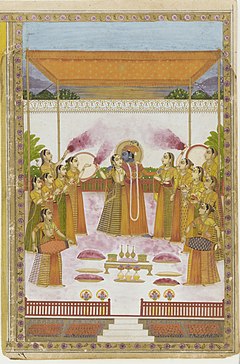
Holi
Hindu spring festival of colours / From Wikipedia, the free encyclopedia
Dear Wikiwand AI, let's keep it short by simply answering these key questions:
Can you list the top facts and stats about Holi?
Summarize this article for a 10 year old
Holi (Hindi pronunciation: ['hoːli:]) is a popular and significant Hindu festival celebrated as the Festival of Colours, Love, and Spring.[1][10][11][12] It celebrates the eternal and divine love of the deities Radha and Krishna.[13][14] Additionally, the day signifies the triumph of good over evil,[15][16] as it commemorates the victory of Vishnu as Narasimha over Hiranyakashipu.[17][18] Holi originated and is predominantly celebrated in the Indian subcontinent of India and Nepal, but has also spread to other regions of Asia and parts of the Western world through the Indian diaspora.[11][19][20][21][22][23][24][25]
| Holi | |
|---|---|
 | |
| Observed by | Hindus,[1] Jains,[2][3] and others[4] |
| Type | Religious, cultural, spring festival |
| Significance |
|
| Celebrations | Night before Holi: Holika Dahan or Kama Dahan On Holi: Playing with coloured powder and water, dancing, greetings, festival delicacies[5] |
| Date | Phalguna Purnima |
| 2025 date | 14 March in India[6] 24 March in Nepal (hilly region) 25 March in Nepal (terai region)[7][8] 24 March in Nepal[9] |
| Frequency | Annual |
| Related to | Hola Mohalla, Shigmo and Yaosang |
Hindu festival dates The Hindu calendar is lunisolar but most festival dates are specified using the lunar portion of the calendar. A lunar day is uniquely identified by three calendar elements: māsa (lunar month), pakṣa (lunar fortnight) and tithi (lunar day). Furthermore, when specifying the masa, one of two traditions are applicable, viz. amānta / pūrṇimānta. If a festival falls in the waning phase of the moon, these two traditions identify the same lunar day as falling in two different (but successive) masa. A lunar year is shorter than a solar year by about eleven days. As a result, most Hindu festivals occur on different days in successive years on the Gregorian calendar. | |
Holi also celebrates the arrival of Spring in India and Nepal, the end of winter, and the blossoming of love.[19][26] It is also an invocation for a good spring harvest season.[19][26] It lasts for a night and a day, starting on the evening of the Purnima (full moon day) falling on the Hindu calendar month of Phalguna, which falls around the middle of March in the Gregorian calendar.